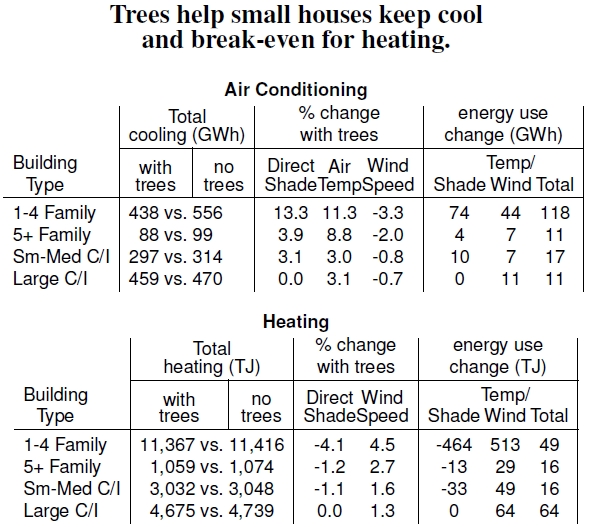3.15 Trees, Cooling, & Heating
Figure 3.15: Energy savings for cooling and heating in Sacramento, California (after Simpson 1998). Overall, winter heating uses much more energy than summer cooling. The two main effects of trees, reduced wind speeds and increased shade, have competing energy consequences for smaller residential buildings. In summer, more shade (and resulting cooler temperatures) and more wind reduce energy costs, while in winter, less shade and less wind reduce energy costs. Summertime shade benefits greatly exceed the costs of reduced breezes, while in winter, the advantages and disadvantages roughly balance. One gigawatt-hour (GWh = 109 Watt-hours) equals 3.6 terajoules (TJ = 1012 Joules).
Trees reduce summer energy use, but what about winter? At least in the Sacramento climate, the tables in Figure 3.15 show that heating uses much more energy than cooling, about 20 times more, and trees affect that energy use very minimally. In summer and winter, trees shade buildings (making buildings cooler) and reduce wind (lessening heat transfer). More shade and more wind are good things in summer, but during the winter, energy efficiency demands less of both. Deciduous trees — those that lose their leaves — trade off the competing demands best, but not perfectly. They provide shade but reduce wind in summer, and shade less but let breezes pass through during the winter. These results show that increased winter energy costs from shade roughly offset benefits of reduced wind speed, with just a little bit of net benefit. Overall, it’s estimated that Sacramento saves almost $19 million in annual energy costs due to the presence of its roughly 3 million urban trees, about $6 per tree, and about $48 per resident.[71]
Putting your house in a park, or better yet, turning your lot into a park, can have tremendous energy-saving possibilities. One study moved eight potted trees around a couple of houses in Sacramento, finding energy savings of up to 30% for cooling.[72] These savings increased to 50% for trailer houses, which tend to have lower insulation and leakier construction.[73] Another study, during warm days in Davis, California, measured 2C temperature reductions within a small forest, 150 m by 300 m, compared to bare fields. Of course, that’s a big urban park full of trees, about 4.5 hectares, something over 10 acres. However, the study noted that such a big stand wasn’t needed: Five meters (15 ft) into the stand the temperature reduction reaches 65% of its maximum (see the sharp thermal boundaries in Figure 2.1), with 50% windspeed reduction.[74] In this case, researchers argued that reduced wind minimizes infiltration into leaky houses, preserving the interior air-conditioned air.
The balance between winter and summer energy costs and benefits depends crucially on location, and results for Sacramento have doubtful implications for Durham, North Carolina, or Minneapolis, Minnesota. These studies demand repetition in each urban area, right down to individual neighborhoods. For example, newer, well-insulated houses have lower possibilities for tree-related energy savings.[75] Across a city, imagine having as much information as possible on buildings, trees, and impervious surfaces, along with electricity, heating, and water use: Crunch all the numbers to understand the most efficient situations to improve the least efficient.[76]
—————————-
[71]Simpson (1998) examined trees around buildings in Sacramento, California.
[72]Akbari (2002) describes manipulating trees around houses to study energy savings.
[73]Akbari (2002) cites Parker (1981) for energy savings for trailer houses.
[74]Taha et al. (1991) studied temperature reductions in Davis, California.
[75]Huang et al. (1987) examine many features of house-level energy savings, including insulation.
[76]How many cities have such a database? Could the costs of adding another city employee for this type of study pay for itself in terms of reduced energy and health costs across a city?

A little more explanation of this table: Take the first line of Air Conditioning, “1-4 Family”. Without trees, the energy use is 556 GWh. With trees, this number is reduced by 13.3% through “Direct Shade”. The three effects, Direct Shade+Air Temp+Wind Speed, add up to a total change of 21.3%. Reducing 556 GWh by 21.3% gives 438GWh.